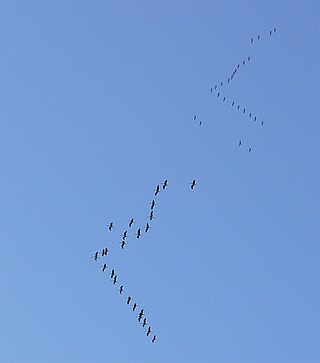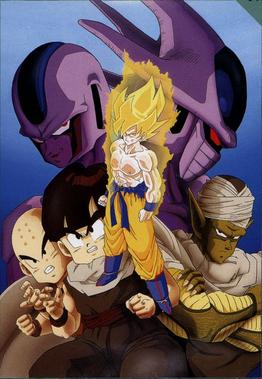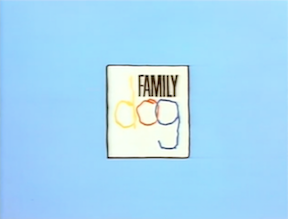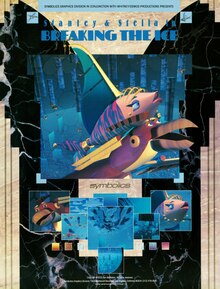Symbolics, Inc., was a privately held American computer manufacturer that acquired the assets of the former company and continues to sell and maintain the Open Genera Lisp system and the Macsyma computer algebra system.

Flocking is the behavior exhibited when a group of birds, called a flock, are foraging or in flight. Sheep and goats also exhibit flocking behavior.

Motion blur is the apparent streaking of moving objects in a photograph or a sequence of frames, such as a film or animation. It results when the image being recorded changes during the recording of a single exposure, due to rapid movement or long exposure.

Boids is an artificial life program, developed by Craig Reynolds in 1986, which simulates the flocking behaviour of birds, and related group motion. His paper on this topic was published in 1987 in the proceedings of the ACM SIGGRAPH conference. The name "boid" corresponds to a shortened version of "bird-oid object", which refers to a bird-like object. Reynolds' boid model is one example of a larger general concept, for which many other variations have been developed since. The closely related work of Ichiro Aoki is noteworthy because it was published in 1982 — five years before Reynolds' boids paper.

Karl Sims is a computer graphics artist and researcher, who is best known for using particle systems and artificial life in computer animation.

The Iron Giant is a 1999 American animated science fiction film produced by Warner Bros. Feature Animation and directed by Brad Bird in his directorial debut. It is based on the 1968 novel The Iron Man by Ted Hughes, and was written by Tim McCanlies from a story treatment by Bird. The film stars the voices of Jennifer Aniston, Harry Connick Jr., Vin Diesel, James Gammon, Cloris Leachman, John Mahoney, Eli Marienthal, Christopher McDonald, and M. Emmet Walsh. Set during the Cold War in 1957, the film centers on a young boy named Hogarth Hughes, who discovers and befriends a giant alien robot. With the help of a beatnik artist named Dean McCoppin, Hogarth attempts to prevent the U.S. military and Kent Mansley, a paranoid federal agent, from finding and destroying the Giant.

Knick Knack is a 1989 American animated short film produced by Pixar that was written and directed by John Lasseter. The short is about a snow globe snowman who wants to join the other travel souvenirs in a summer-themed party. However, the glass dome that surrounds him prevents him from doing so, thus leading to his many tries to break out of his snow globe. Knick Knack is Pixar's fourth short and the final short produced during the company's tenure as a hardware company. It was also the final Pixar short film released before the company's first feature-length film Toy Story.

Dragon Ball Z: Cooler's Revenge is a 1991 Japanese anime science fiction martial arts film and the fifth Dragon Ball Z animated feature film, originally released in Japan on July 20 at the Toei Anime Fair. It was preceded by Dragon Ball Z: Lord Slug and followed by Dragon Ball Z: The Return of Cooler.
VirtualMagic Animation, Inc. was an American traditional animation studio and software development company based out of Los Angeles, California. The studio produced animation for television series and commercials, and provided ink and paint services to animated TV series such as The Ren and Stimpy Show and The Simpsons and films such as We're Back! A Dinosaur's Story. Its software division was best known for developing USAnimation, a high-end software package designed to facilitate the traditional animation process using digital technologies.

Family Dog is an adult animated sitcom created by Brad Bird for CBS. It is based on a 1987 episode of Amazing Stories. It originally aired for a single season with ten episodes, from June 23 to July 28, 1993. The series was about an average suburban family, the Binsfords, as told through the eyes of their dog named Jonah. The series was the first collaboration between executive producers Steven Spielberg and Tim Burton. It was also the first adult animated series produced by Nelvana, predating Bob and Margaret.

Lennon Legend: The Very Best of John Lennon is a DVD that was released in November 2003, alongside the album of the same name. It features a series of remastered, remixed, and new videos with Dolby Digital 5.1 Surround Sound audio mixes.

Michael Arias is an American-born filmmaker active primarily in Japan.
The history of computer animation began as early as the 1940s and 1950s, when people began to experiment with computer graphics – most notably by John Whitney. It was only by the early 1960s when digital computers had become widely established, that new avenues for innovative computer graphics blossomed. Initially, uses were mainly for scientific, engineering and other research purposes, but artistic experimentation began to make its appearance by the mid-1960s – most notably by Dr. Thomas Calvert. By the mid-1970s, many such efforts were beginning to enter into public media. Much computer graphics at this time involved 2-D imagery, though increasingly as computer power improved, efforts to achieve 3-D realism became the emphasis. By the late 1980s, photo-realistic 3-D was beginning to appear in film movies, and by mid-1990s had developed to the point where 3-D animation could be used for entire feature film production.
Angry Birds is a Finnish action, puzzle, and strategy based media franchise created by Rovio Entertainment, and owned by Sega. The game series focuses on the titular flock of colorful angry birds who try to save their eggs from green-colored pigs. Inspired by the game Crush the Castle, the game has been praised for its successful combination of fun gameplay, comical style, and low price. Its popularity led to many spin-offs; versions of Angry Birds created for PCs and video game consoles, a market for merchandise featuring its characters, Angry Birds Toons, a televised animated series, and two films; The Angry Birds Movie and its sequel The Angry Birds Movie 2. By January 2014, there had been over 2 billion downloads across all platforms, including both regular and special editions.
Jan Nickman is an American film and television director, producer, cinematographer and writer. As the co-founder of Miramar Images, Inc. and Sacred Earth Pictures, Nickman's career in film and television spans three decades.
Physically based animation is an area of interest within computer graphics concerned with the simulation of physically plausible behaviors at interactive rates. Advances in physically based animation are often motivated by the need to include complex, physically inspired behaviors in video games, interactive simulations, and movies. Although off-line simulation methods exist to solve most all of the problems studied in physically-based animation, these methods are intended for applications that necessitate physical accuracy and slow, detailed computations. In contrast to methods common in offline simulation, techniques in physically based animation are concerned with physical plausibility, numerical stability, and visual appeal over physical accuracy. Physically based animation is often limited to loose approximations of physical behaviors because of the strict time constraints imposed by interactive applications. The target frame rate for interactive applications such as games and simulations is often 25-60 hertz, with only a small fraction of the time allotted to an individual frame remaining for physical simulation. Simplified models of physical behaviors are generally preferred if they are more efficient, easier to accelerate, or satisfy desirable mathematical properties. Fine details are not important when the overriding goal of a visualization is aesthetic appeal or the maintenance of player immersion since these details are often difficult for humans to notice or are otherwise impossible to distinguish at human scales.

Michael Kass is an American computer scientist best known for his work in computer graphics and computer vision. He has won an Academy Award and the SIGGRAPH Computer Graphics Achievement Award and is an ACM Fellow.

Behnaz Farahi is an Iranian-born American interdisciplinary designer and educator whose work melds architecture, fashion, interaction design, computational design, wearable technology and the human body. Her designs often explore the possibilities of human interaction with the environment and how technology can facilitate this interplay. Her work engages with the human body's relationship to its surroundings and how wearable technology can respond to, or be influenced by stimuli such as human emotions or environmental factors. Leveraging technology and art, Farahi's works are commentaries on power dynamics, society, and identity, frequently drawing inspiration from her cultural background and Western theories and practices, underpinned by theoretical concepts including socio-political feminist theory and anthropology.

A virtual human is a software fictional character or human being. Virtual human have been created as tools and artificial companions in simulation, video games, film production, human factors and ergonomic and usability studies in various industries, clothing industry, telecommunications (avatars), medicine, etc. These applications require domain-dependent simulation fidelity. A medical application might require an exact simulation of specific internal organs; film industry requires highest aesthetic standards, natural movements, and facial expressions; ergonomic studies require faithful body proportions for a particular population segment and realistic locomotion with constraints, etc.

IF is an upcoming American live-action/animated fantasy comedy film written, produced, and directed by John Krasinski. The film features an ensemble cast that includes Cailey Fleming, Ryan Reynolds, Krasinski, Fiona Shaw, Alan Kim, and Liza Colón-Zayas, along with the voices of Phoebe Waller-Bridge, Louis Gossett Jr., and Steve Carell. Its plot follows a young girl and her neighbor who find themselves able to see imaginary friends.













